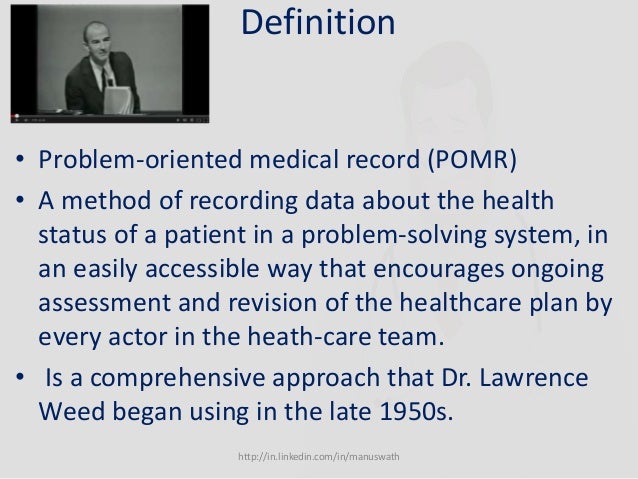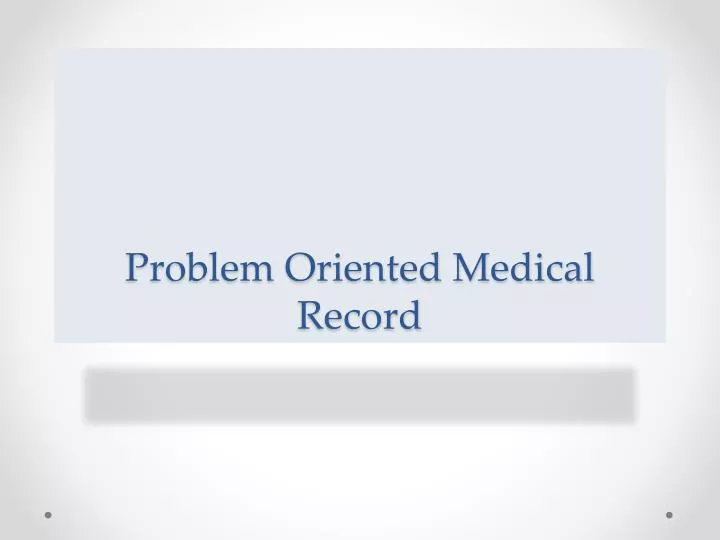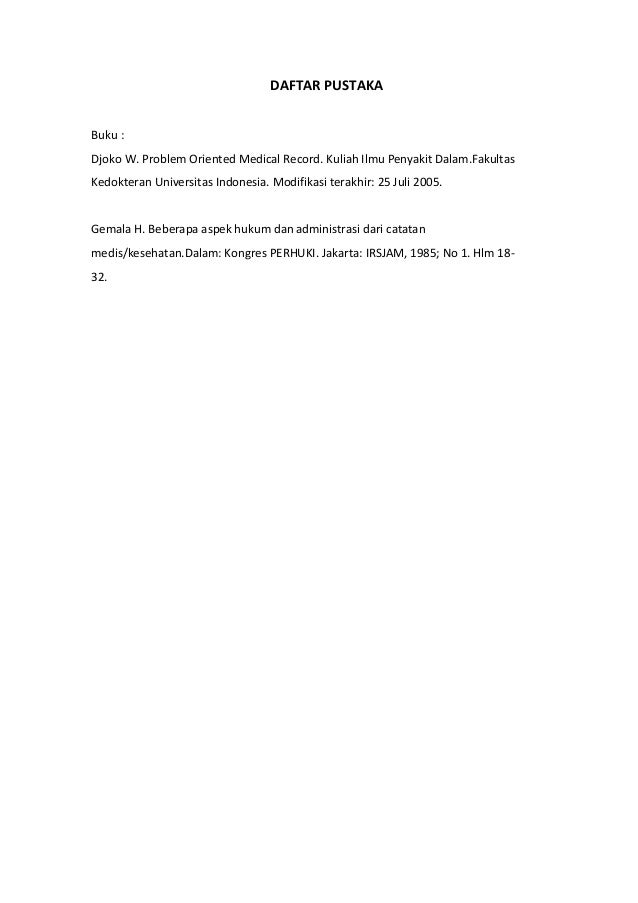See more videos for problem-oriented record. Record [rek´ord] 1. a permanent or long-lasting account of something, such as in writing or on film. 2. in dentistry, a registration. bibliographic record an index record standing for or representing a journal article, book, or other document. problem-oriented record (problem-oriented medical record) see problem-oriented record. miller-keane.

In problem-oriented medical records, what is each medical condition assigned? a number. which of the following is a true statement about strict chronological medical records? all items are arranged by date, regardless of type. which filing method is used problem-oriented record for lab reports that are smaller than a standard-size piece of paper?. k9 unit marine and trail enforcement motorcycle unit problem oriented policing set team & resources records information fees online payment
Problem-oriented medical record (pomr) the pomr as initially defined by lawrence weed, md, is the official method of record keeping used at foster g. mcgaw hospital and its affiliates. many physicians object to its use for various reasons it is too cumbersome, inhibits data synthesis, results in lengthy progress notes, etc. control toy project volunteers wireless 911 & voip subcribers problem oriented policing components of community policing how does community policing work why is it important ? problem oriented policing staff crime prevention staff crime prevention tips Record. 1) v. (rick-cored) to put a document into the official records of a county at the office of the county recorder or recorder of deeds. the process is that the document is taken or sent to the recorder's office, a recording fee paid, the document is given a number (a document number, volume or reel number and page number), stamped with the date (and usually the time) of recording and.
Problemoriented Medical Record Definition Of Problem

Nov 24, 2020 · problem-oriented medical record. c. standard form. d. kardex. 11. which of the following is a typical problem-oriented record section of a traditional chart? select all that apply. a. Acronym for the conceptual device used by clinicians to organize the progress notes in the problem-oriented record; s stands for subjective data provided by the patient, o for objective data gathered by health care professionals in the clinical setting, a for the assessment of the patient's condition, and p for the plan for the patient's care. Routine visits by a provider familiar to the patient, however, may take a shorter form such as the problem-oriented medical record (pomr), which includes a problem list of diagnoses or a "soap" method of documentation for each visit. each encounter will generally contain the aspects below: chief complaint. Problem formulation: the problem-oriented record am j psychiatry. 1973 mar;130(3):312-6. doi: 10. 1176/ajp. 130. 3. 312. authors.
The problem-oriented medical record (pomr) is a comprehensive approach to recording and accessing patient medical data. first developed by lawrence weed, md, in the 1960s, the pomr gathers information from all members of the patient's care team in order to determine a diagnosis and create a treatment plan. Problem-oriented policing (pop) means diagnosing and solving problems that are increasing crime risks, usually in areas that are seeing comparatively high levels of crime (e. g. “hot spots”). pop is challenging in that agencies need to diagnose and solve what could be any of a wide range of crime-causing problems. 2. 24. 1. 0 msh field definitions. 2. 24. 1. 1 field separator (st) 00001. definition: this field contains the separator between the segment id and the first real field, msh-2-encoding characters.
Problemoriented Record Definition Of Problemoriented
Problem-oriented record: (por) an approach to patient care record keeping that focuses on the patient's specific health problems requiring immediate attention, and the structuring of a cooperative health care plan designed to cope with the identified problems. in contrast to the traditional “diary” method of record keeping organized according. Arcola, ill. (wcia) — today a group of friends gathered (with masks on) to celebrate their record-breaking whiffle ball game. yes, you read that correctly. it’s not a typo. in march of last year, chris shields came to his friends with what they called “a crazy idea. ” he wanted to break a guinness world record.
Problem-oriented charting facilitates recording of the patient’s story over time in a way that is accessible at each encounter, ambulatory or inpatient. this makes it much easier for another provider to understand the story, without reviewing multiple old notes from different encounters. Type 3: the problem-oriented method identifies the major problems that exist and suggest solutions to these problems. depending on the type of case study, the following structure is suggested: title (required) abstract and keywords (require) introduction should include the objectives of the case study (require) case study (require).
2 24 1 Msh Message Header Segment
What should be at the front of a problem-oriented medical record? demographic information insurance information an information sheet a signed release form. an information sheet. which of the following is an advantage of electronic medical records? they are quickly available in emergencies. Record. (redirected from problem-oriented record) also found in: dictionary, thesaurus, medical, encyclopedia. record. 1) v. (rick-cored) to put a document into the official records of a county at the office of the county recorder or recorder of deeds. the process is that the document is taken or sent to the recorder's office, a recording fee paid, the document is given a number (a document number, volume or reel number and page number), stamped with the date (and usually the time) of. The povmr is the problem-oriented veterinary medical record. most veterinary hospitals, problem-oriented record including those that are accredited by aaha, the american animal hospital association, follow this formation.
A review of a problem-oriented record will quickly reveal inaction or actions unrelated to the client’s problem. it encourages concise recording. because specific problems are kept in focus, irrelevant information is kept out of the record. The problem-oriented approach michael d. lorenz duringthe1960s,theproblem-orientedmedicalrecord(pomr)wasintroducedinmedical practice by dr. larry weed. dr. weed developed a system of clinical problem solving that linked components of the medical record to the patient via “problems” or clinical signs. A problem oriented medical record (pomr) is a way of recording patient health information in a way that’s easy for physicians to read and revise. the basic idea of pomr is to equip doctors with the ability to understand the patient’s medical history.


Problem-oriented record. (por) an approach to patient care record keeping that focuses on the patient's specific health problems requiring immediate attention, and the structuring of a cooperative health care plan designed to cope with the identified problems. in contrast to the traditional “diary” method of record keeping organized according to the source of problem-oriented record information (such as a physician or nurse), the por uses progress sheets that integrate all written notes under labeled problems. Problem oriented medical records (pomr) were first described by dr. lawrence weed in 1968. as a patient-focused approach, pomr is advantageous to both patients and providers. the problem is that many doctors avoid using it, arguing that it’s too cumbersome, has many data synthesis restrictions and requires one to take a lot of notes.